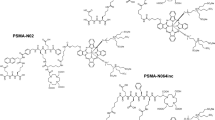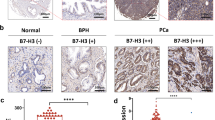Abstract
Purpose
This study aimed to create new optical surgical navigation NIRF probes for prostate and breast cancers.
Procedures
IR800-linker-QWAVGHLM-NH2 with linker = GSG, GGG, and G-Abz4 were synthesized and characterized. IC50 for bombesin receptors (BBN-R) in PC-3 prostate and T47D breast cancer cells, fluorescence microscopy in PC-3 cells, and NIRF imaging in mice PC-3 tumor xenografts were studied.
Results
GGG, GSG, and G-Abz4 derivatives had IC50 (nM) for BBN-R+ PC-3 cells = 187 ± 31, 56 ± 5, and 2.6 ± 0.2 and T47D cells = 383 ± 1, 57.4 ± 1.2, and 3.1 ± 1.1, respectively. By microscopy the Abz4 derivative showed the highest uptake, was competed with by BBN, and had little to no binding to BBN-R− cells. In NIRF imaging the G-Abz4 probe was brighter than GGG probe in BBN-R+ tissues in vivo and tissues, tumors, and tumor slices ex vivo. Uptake could be partially blocked in BBN-R+ pancreas but not visibly in tumor.
Conclusions
Linker choice can dominate peptidic BBN-R binding. The G-Abz4 linker yields a higher affinity and specific BBN-R binder in this series of molecules.






Similar content being viewed by others
Abbreviations
- GRP:
-
Gastrin-releasing peptide
- NIRF:
-
Near-infrared fluorescent
- BBN:
-
Bombesin
- BBN-R:
-
Bombesin receptors
- Abz-4:
-
4-aminobenzoic acid
References
Nguyen QT, Tsien RY (2013) Fluorescence-guided surgery with live molecular navigation—a new cutting edge. Nat Rev Cancer 13:653–662
Keereweer S, Sterenborg HJ, Kerrebijn JD et al (2012) Image-guided surgery in head and neck cancer: current practice and future directions of optical imaging. Head Neck 34:120–126
Azhdarinia A, Ghosh P, Ghosh S et al (2012) Dual-labeling strategies for nuclear and fluorescence molecular imaging: a review and analysis. Mol Imaging Biol 14:261–276
Kovar JL, Simpson MA, Schutz-Geschwender A, Olive DM (2007) A systematic approach to the development of fluorescent contrast agents for optical imaging of mouse cancer models. Anal Biochem 367:1–12
Berezin MY, Guo KV, Akers W et al (2011) Rational approach to select small peptide molecular probes labeled with fluorescent cyanine dyes for in vivo optical imaging. Biochemistry-US 50:2691–2700
Marshall MV, Draney D, Sevick-Muraca EM, Olive DM (2010) Single-dose intravenous toxicity study of IRDye 800CW in Sprague–Dawley rats. Mol Imaging Biol 12:583–594
Gong H, Kovar J, Little G et al (2010) In vivo imaging of xenograft tumors using an epidermal growth factor receptor-specific affibody molecule labeled with a near-infrared fluorophore. Neoplasia 12:139–149
Qi S, Miao Z, Liu H et al (2012) Evaluation of four affibody-based near-infrared fluorescent probes for optical imaging of epidermal growth factor receptor positive tumors. Bioconjug Chem. doi:10.1021/bc200596a
Terwisscha van Scheltinga AG, van Dam GM, Nagengast WB et al (2011) Intraoperative near-infrared fluorescence tumor imaging with vascular endothelial growth factor and human epidermal growth factor receptor 2 targeting antibodies. J Nucl Med 52:1778–1785
Wu F, Tamhane M, Morris ME (2012) Pharmacokinetics, lymph node uptake, and mechanistic PK model of near-infrared dye-labeled bevacizumab after IV and SC administration in mice. AAPS J 14:252–261
Kovar JL, Volcheck W, Sevick-Muraca E et al (2009) Characterization and performance of a near-infrared 2-deoxyglucose optical imaging agent for mouse cancer models. Anal Biochem 384:254–262
Levi J, Cheng Z, Gheysens O et al (2007) Fluorescent fructose derivatives for imaging breast cancer cells. Bioconjug Chem 18:628–634
Chen Y, Dhara S, Banerjee SR et al (2009) A low molecular weight PSMA-based fluorescent imaging agent for cancer. Biochem Biophys Res Commun 390:624–629
Liu T, Nedrow-Byers JR, Hopkins MR, Berkman CE (2011) Spacer length effects on in vitro imaging and surface accessibility of fluorescent inhibitors of prostate specific membrane antigen. Bioorg Med Chem Lett 21:7013–7016
Meincke M, Tiwari S, Hattermann K et al (2011) Near-infrared molecular imaging of tumors via chemokine receptors CXCR4 and CXCR7. Clin Exp Metastasis 28:713–720
Yang Y, Zhang Y, Hong H et al (2011) In vivo near-infrared fluorescence imaging of CD105 expression during tumor angiogenesis. Eur J Nucl Med Mol Imaging 38:2066–2076
Zhao D, Stafford JH, Zhou H, Thorpe PE (2011) Near-infrared optical imaging of exposed phosphatidylserine in a mouse glioma model. Transl Oncol 4:355–364
Stafford JH, Thorpe PE (2011) Increased exposure of phosphatidylethanolamine on the surface of tumor vascular endothelium. Neoplasia 13:299–308
Ye Y, Zhu L, Ma Y et al (2011) Synthesis and evaluation of new iRGD peptide analogs for tumor optical imaging. Bioorg Med Chem Lett 21:1146–1150
Lee S, Xie J, Chen XY (2010) Peptides and peptide hormones for molecular imaging and disease diagnosis. Chem Rev 110:3087–3111
Reubi JC, Maecke HR (2008) Peptide-based probes for cancer imaging. J Nucl Med 49:1735–1738
Ohki-Hamazaki H, Iwabuchi M, Maekawa F (2005) Development and function of bombesin-like peptides and their receptors. Int J Dev Biol 49:293–300
Markwalder R, Reubi JC (1999) Gastrin-releasing peptide receptors in the human prostate: relation to neoplastic transformation. Cancer Res 59:1152–1159
Reubi JC (2003) Peptide receptors as molecular targets for cancer diagnosis and therapy. Endocr Rev 24:389–427
Reubi JC, Korner M, Waser B et al (2004) High expression of peptide receptors as a novel target in gastrointestinal stromal tumours. Eur J Nucl Med Mol Imaging 31:803–810
Reubi JC, Macke HR, Krenning EP (2005) Candidates for peptide receptor radiotherapy today and in the future. J Nucl Med 46:67S–75S
Reubi JC, Wenger S, Schmuckli-Maurer J et al (2002) Bombesin receptor subtypes in human cancers: detection with the universal radioligand 125I-[D-TYR6, β-ALA11, PHE13, NLE14] Bombesin (6–14). Clin Cancer Res 8:1139–1146
Fleischmann A, Waser B, Reubi JC (2007) Overexpression of gastrin-releasing peptide receptors in tumor-associated blood vessels of human ovarian neoplasms. Cell Oncol 29:421–433
Lango MN, Dyer KF, Lui VW et al (2002) Gastrin-releasing peptide receptor-mediated autocrine growth in squamous cell carcinoma of the head and neck. J Natl Cancer Inst 94:375–383
Fleischmann A, Waser B, Reubi JC (2009) High expression of gastrin-releasing peptide receptors in the vascular bed of urinary tract cancers: promising candidates for vascular targeting applications. Endocr Relat Cancer 16:623–633
Lantry LE, Cappelletti E, Maddalena ME et al (2006) 177Lu-AMBA: synthesis and characterization of a selective 177Lu-labeled GRP-R agonist for systemic radiotherapy of prostate cancer. J Nucl Med 47:1144–1152
Cagnolini A, Chen J, Ramos K et al (2010) Automated synthesis, characterization and biological evaluation of [(68)Ga]Ga-AMBA, and the synthesis and characterization of (nat)Ga-AMBA and [(67)Ga]Ga-AMBA. Appl Radiat Isot 68:2285–2292
Fani M, Maecke HR, Okarvi SM (2012) Radiolabeled peptides: valuable tools for the detection and treatment of cancer. Theranostics 2:481–501
Fani M, Maecke HR (2012) Radiopharmaceutical development of radiolabelled peptides. Eur J Nucl Med Mol Imaging 39(Suppl 1):S11–S30
Bohme I, Beck-Sickinger AG (2009) Illuminating the life of GPCRs. Cell Commun Signal 7:16
Achilefu S, Jimenez HN, Dorshow RB et al (2002) Synthesis, in vitro receptor binding, and in vivo evaluation of fluorescein and carbocyanine peptide-based optical contrast agents. J Med Chem 45:2003–2015
Ma L, Yu P, Veerendra B et al (2007) In vitro and in vivo evaluation of Alexa Fluor 680-bombesin[7-14]NH2 peptide conjugate, a high-affinity fluorescent probe with high selectivity for the gastrin-releasing peptide receptor. Mol Imaging 6:171–180
Hong FD, Clayman GL (2000) Isolation of a peptide for targeted drug delivery into human head and neck solid tumors. Cancer Res 60:6551–6556
Chen J, Linder KE, Cagnolini A et al (2008) Synthesis, stabilization and formulation of [177Lu]Lu-AMBA, a systemic radiotherapeutic agent for gastrin releasing peptide receptor positive tumors. Appl Radiat Isot 66:497–505
Lantry LE, Cappelletti E, Maddalena ME et al (2006) Lu-177-AMBA: synthesis and characterization of a selective Lu-177-labeled GRP-R agonist for systemic radiotherapy of prostate cancer. J Nucl Med 47:1144–1152
Wang S-H, Ding H, Shrivastava A, Tweedle MF (2013) Study of Bombesin receptor family in breast cancer cells [abstract]
Choi HS, Nasr K, Alyabyev S et al (2011) Synthesis and in vivo fate of zwitterionic near-infrared fluorophores. Angew Chem Int Ed Engl 50:6258–6263
Choi HS, Gibbs SL, Lee JH et al (2013) Targeted zwitterionic near-infrared fluorophores for improved optical imaging. Nat Biotechnol 31:148–153
Garrison JC, Rold TL, Sieckman GL et al (2008) Evaluation of the pharmacokinetic effects of various linking group using the 111In-DOTA-X-BBN(7-14)NH2 structural paradigm in a prostate cancer model. Bioconjug Chem 19:1803–1812
Cai QY, Yu P, Besch-Williford C et al (2013) Near-infrared fluorescence imaging of gastrin releasing peptide receptor targeting in prostate cancer lymph node metastases. Prostate 73:842–854
Acknowledgments
Funding sources for this research are The Ohio State University College of Medicine, The Stefanie Spielman Foundation, and NIH 1 S10 RR025660-01A1.
Conflict of Interest
The authors declare that they have no conflict of interest.
Author information
Authors and Affiliations
Corresponding author
Additional information
Ajay Shrivastava and Haiming Ding contributed equally to this work
Electronic supplementary material
HPLC traces of synthesized compounds, analytical data on synthesized molecules, additional mice organ and body images, and structures of two commercial fluors compared.
ESM 1
(PDF 1802 kb)
Rights and permissions
About this article
Cite this article
Shrivastava, A., Ding, H., Kothandaraman, S. et al. A High-Affinity Near-Infrared Fluorescent Probe to Target Bombesin Receptors. Mol Imaging Biol 16, 661–669 (2014). https://doi.org/10.1007/s11307-014-0727-2
Published:
Issue Date:
DOI: https://doi.org/10.1007/s11307-014-0727-2




